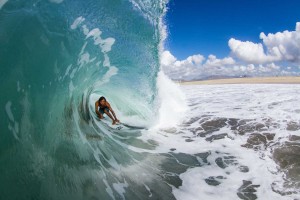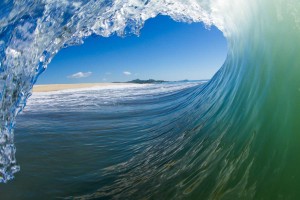
Filmmaker Mark Kronemeyer recently turned to Burbank-based AlphaDogs to handle postproduction for his new film Gone, which takes audiences on a tour of Mexico in search of the perfect surfing conditions.
“I got the idea for the film traveling around Mexico and documenting our journey up and down the Pacific coast,” said Kronemeyer. “I hope audiences will want to travel and discover more of the real Mexico after watching Gone.”
Kronemeyer chose AlphaDogs after working with them on his first surf movie Rumors in 2010. “I was inspired to make another film after making Rumors,” said Kronemeyer. “I came to AlphaDogs again because they understand the concept and story of the film really well and treated my project as if it was their own.”
In charge of creating the look for the film was AlphaDogs colorist Sean Stack. Edited in Final Cut Pro X by Kronemeyer, Gone required a round-trip workflow into DaVinci Resolve before the color grading process could begin. This required matching mixed-media frame rates between FCP X and Resolve. Round-tripping often causes playback judder if not done properly. In order to avoid this problem, Stack rendered the footage out of Resolve using the original source frame rate, allowing for adjustment on playback quality to happen back in the editing application. Non-native frame rates can sometimes appear jittery, which is especially problematic with action footage. An inexpensive and easy solution was to use Cinema Tools on short clips to simply convert the playback rate to match the timeline. Although there is a slight speed ramp applied when doing this, it’s typically not noticeable on shorter clips.
“Fixing problems with mixed-media frame rates are done on a case-by-case basis, as there isn’t one universal panacea,” explained Stack. “We tend to combine hardware solutions, like Blackmagic‘s Teranex, with assorted software solutions and rely on experience to determine which approach is best for any given footage.”
 Shot in various locations throughout Mexico, Gone encompasses a wide variety of beach terrain. To give each location its own personality and character, Stack made specific creative color decisions, such as making southern beaches more teal and green in color, while adding more blue and purples/reds into the shadows of the surf on northern beaches. Kronemeyer specifically wanted the sections of larger waves to appear even more dangerous and menacing. Stack achieved this look by punching up the blue in the surf, making the water appear darker and in turn giving the waves a deeper and more hazardous look. “It added to the excitement of the surfing and the surfers really popped off the background. You could see the action clearly,” said Stack.
Shot in various locations throughout Mexico, Gone encompasses a wide variety of beach terrain. To give each location its own personality and character, Stack made specific creative color decisions, such as making southern beaches more teal and green in color, while adding more blue and purples/reds into the shadows of the surf on northern beaches. Kronemeyer specifically wanted the sections of larger waves to appear even more dangerous and menacing. Stack achieved this look by punching up the blue in the surf, making the water appear darker and in turn giving the waves a deeper and more hazardous look. “It added to the excitement of the surfing and the surfers really popped off the background. You could see the action clearly,” said Stack.
While FCPX and Resolve workflows are mostly reliable when it comes to round-trip accuracy, Stack always makes sure he always has a QuickTime reference movie with time code delivered to the color session before any conforming begins. “Without this roadmap, commonly known as a chase reference, I cannot guarantee sync with the original offline locked cut,” explained Stack. “The audio mixer should use the same chase reference as the colorist, as this will further guarantee that the mix stems will sync up perfectly with the color graded final sequence.”
Round-trip workflows also present unique challenges when it comes to audio. Because FCP X doesn’t have the ability to export proper materials for a professional mix, specific steps need to be taken as to not slow down the post audio process. This required AlphaDogs audio engineer Curtis Fritsch to use workaround methods, such as assisted editing X to 7 and streamlining the audio tracks to make the transition from FCP X to Pro Tools. Fritsch then added extra EQ to the low and high end of each song to help elevate the drive of the music to better match the fast pace and lush visuals of the beaches in Mexico. “Gone was one of my favorite and enjoyable mixes in recent memory with the impressive footage and music choices that made it even more fun to work on. With just a few minor changes to the audio I was able to give the film that extra punch, which can be the difference between a good sounding film and a great one,” said Fritsch.





